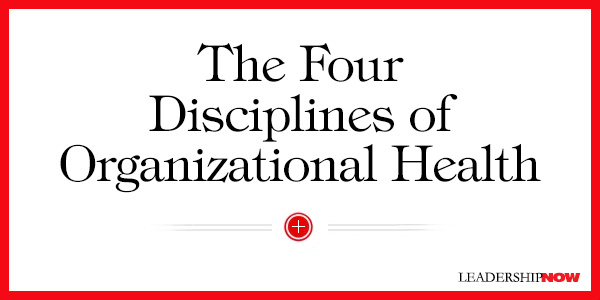 |
 |
03.20.12

The Four Disciplines of Organizational Health
PATRICK LENCIONI believes that the single greatest advantage any company can achieve is organizational health. Unfortunately most leaders prefer to deal with the data-driven world of organizational intelligence. The problem is, without good organizational health, organizational intelligence is attenuated. In The Advantage, Lencioni explains that “an organization is healthy when it’s whole, consistent and complete, when its management, operations, strategy and culture fit together and make sense. You know you have it when you have minimal politics and confusion, high degrees of morale and productivity, and very low turnover among good employees.” Additionally, the value of a healthy organization has a ripple effect that affects all who come into contact with it or its employees. What does an organization have to do to become healthy? Creating a healthy organization is a rigorous endeavor. Lencioni has created a four disciplines model: Discipline 1: Build a Cohesive Leadership Team
Discipline 2: Create Clarity In addition to being behaviorally cohesive, the leadership team of a healthy organization must be intellectually aligned and committed to the same answers to six simple by critical questions:
There can be no daylight between leaders around these fundamental issues. Discipline 3: Over-communicate Clarity Once a leadership team has established behavioral cohesion and created clarity around the answers to those questions, it must then communicate those answers to employees clearly, repeatedly, enthusiastically and repeatedly (that’s not a typo). When it comes to reinforcing clarity, there is no such thing as too much communication. As tempting as it may be, leaders must not abdicate or delegate responsibility for community and reinforcement of clarity. Instead, they have to play the tireless role of ensuring that employees throughout the organization are continually and repeatedly reminded about what is important. Discipline 4: Reinforce Clarity Finally, in order for an organization to remain healthy over time, its leaders must establish a few critical, non-bureaucratic systems to reinforce clarity in every process—hiring, managing performance, rewards and recognition, employee dismissal—that involves people. These disciplines may sound idealistic—and they are—but health is a matter of degrees. Any improvement will reap benefits. There will always be those that use "idealism" as an excuse to not make the effort; to find this all too remarkable to actually implement. Not surprisingly, the key is leadership. But it is a sacrifice. If an organization is to get healthy, it must have the “genuine and active involvement of the person in charge. For a company, that’s the CEO. For a small business, it’s the owner. For the school, it’s the principal. For the church, it’s the pastor. For a department within a company, it’s the department head….The leader must be out front, not as a cheerleader or a figurehead, but as an active, tenacious driver.” Without the leader's commitment, this model will be sabotaged or seen as “career suicide.” The leader must support it and reward it. 
Posted by Michael McKinney at 07:57 AM
|
BUILD YOUR KNOWLEDGE
 

How to Do Your Start-Up Right STRAIGHT TALK FOR START-UPS 
Grow Your Leadership Skills NEW AND UPCOMING LEADERSHIP BOOKS 
Leadership Minute BITE-SIZE CONCEPTS YOU CAN CHEW ON 
Classic Leadership Books BOOKS TO READ BEFORE YOU LEAD |